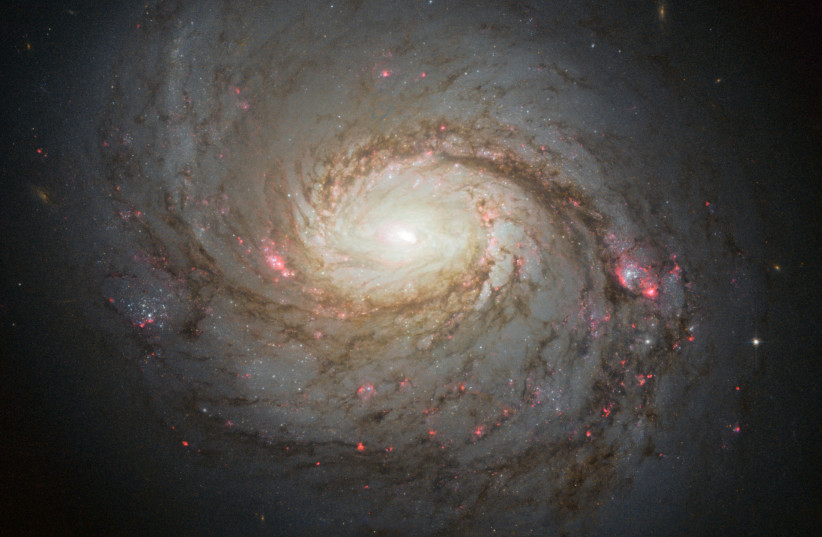High-energy neutrinos were traced back to the NGC 1068 (Messier 77) galaxy for the first time, according to a new, peer-reviewed study published in the journal Science on Friday.
Neutrinos are the most abundant fundamental particles that have mass in the universe and have been detected from many sources, including the sun and cosmic-ray interactions. They are among the least understood particles in the standard model of particle physics.
NGC 1068, located 47 million light-years away from Earth, is an active, spiral galaxy with a massive black hole at its center. A circle of nuclear dust hides most of the high-energy radiation produced by the gas and particles slowly spiraling inward toward the center of the galaxy.
"Recent models of the black hole environments in these objects suggest that gas, dust, and radiation should block the gamma rays that would otherwise accompany the neutrinos," said Hans Niederhausen, a postdoctoral associate at Michigan State University and one of the main analyzers of the paper.
Niederhausen added that the neutrino detection could improve our understanding of the environments around supermassive black holes.

The IceCube Neutrino Observatory
The detection was made at the IceCube Neutrino Observatory, a massive neutrino telescope using 1 billion tons of instrumented ice 1.5 to 2.5 kilometers below the surface of Antarctica.
The IceCube Neutrino Observatory reported the first observation of a high-energy neutrino in 2018 which originated in a blazar galaxy located near the constellation Orion, four billion light-years away.
“One neutrino can single out a source. But only an observation with multiple neutrinos will reveal the obscured core of the most energetic cosmic objects,” said Francis Halzen, a professor of physics at the University of Wisconsin–Madison and principal investigator of IceCube.
Revealing the origin of cosmic neutrinos and the relationship between neutrinos, gamma rays and cosmic rays is a central step to deciphering the fundamental processes in the universe.
IceCube has detected 80 high-energy neutrinos from NGC 1068. These "are not yet enough to answer all our questions, but they definitely are the next big step towards the realization of neutrino astronomy," said Halzen.
Theo Glauch, a postdoctoral associate at the Technical University of Munich (TUM), in Germany, explained that NGC 1068 could become a "standard candle" for future neutrino telescopes.
“It is already a very well-studied object for astronomers, and neutrinos will allow us to see this galaxy in a totally different way. A new view will certainly bring new insights,” said Glauch.
New study greatly improves on previous studies
The new study also presents a significant improvement on a prior study on NGC 1068 published in 2020.
“Part of this improvement came from enhanced techniques and part from a careful update of the detector calibration,” said Ignacio Taboada, a physics professor at the Georgia Institute of Technology and the spokesperson of the IceCube Collaboration. “Work by the detector operations and calibrations teams enabled better neutrino directional reconstructions to precisely pinpoint NGC 1068 and enable this observation. Resolving this source was made possible through enhanced techniques and refined calibrations, an outcome of the IceCube Collaboration’s hard work.”
Marek Kowalski, an IceCube collaborator and senior scientist at Deutsches Elektronen-Synchrotron, in Germany, stated that the new study "means that with a new generation of more sensitive detectors there will be much to discover."
"The future IceCube-Gen2 observatory could not only detect many more of these extreme particle accelerators but would also allow their study at even higher energies. It’s as if IceCube handed us a map to a treasure trove.”
The new study brings IceCube closer to figuring out the origin of cosmic rays. The findings could also mean that more similar objects could be out there in the universe yet to be identified.
“The unveiling of the obscured universe has just started, and neutrinos are set to lead a new era of discovery in astronomy,” said Elisa Resconi, a professor of physics at TUM and another main analyzer on the study.
“Several years ago, NSF initiated an ambitious project to expand our understanding of the universe by combining established capabilities in optical and radio astronomy with new abilities to detect and measure phenomena like neutrinos and gravitational waves,” said Caldwell. “The IceCube Neutrino Observatory’s identification of a neighboring galaxy as a cosmic source of neutrinos is just the beginning of this new and exciting field that promises insights into the undiscovered power of massive black holes and other fundamental properties of the universe.”
